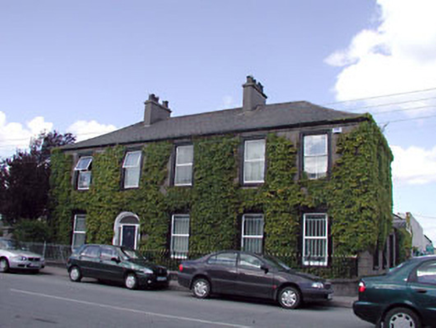Survey Data
Reg No
11818019
Rating
Regional
Categories of Special Interest
Architectural, Artistic, Historical
Original Use
House
Historical Use
Post office
In Use As
Office
Date
1855 - 1865
Coordinates
280322, 215143
Date Recorded
17/02/2003
Date Updated
--/--/--
Description
Attached five-bay two-storey house, built 1860, on a rectangular plan. Replacement hipped fibre-cement slate roof with ridge tiles, rendered chimney stacks having stepped capping supporting terracotta tapered pots, and cast-iron rainwater goods on rendered eaves. Ivy-covered rendered, ruled and lined walls with rusticated rendered quoins to corners. Segmental-headed door opening with threshold supporting cast-iron bootscrapers, timber mullions supporting timber transom, and moulded rendered surround having "Cavetto" reveals framing replacement timber panelled door having sidelights below overlight. Square-headed window openings with sills, and moulded rendered surrounds framing replacement aluminium casement windows replacing two-over-two timber sash windows. Interior including (ground floor): hall retaining timber surrounds to door openings framing timber panelled doors, moulded plasterwork cornice to ceiling, staircase with turned timber balusters supporting timber banister terminating in turned timber newel, and timber surrounds to door openings to landing framing timber panelled doors. Street fronted on a corner site with galvanised mild steel railings to perimeter.
Appraisal
A house erected by Michael Flood (1822-90) representing an integral component of the mid nineteenth-century domestic built heritage of Newbridge with the architectural value of the composition suggested by such attributes as the rectilinear plan form; and the very slight diminishing in scale of the openings on each floor producing a feint graduated visual impression. NOTE: Charlotte House is featured in a photograph of Charlotte Street by William Lawrence (1840-1932) and shows a symmetrically-composed shopfront carrying the name of the draper and milliner Michael Flood (1822-90) [NLI vtls000560632]. The "Kildare Observer" published a preliminary notice for an 'EXECUTOR'S SALE...BY AUCTION On an EARLY DAY IN AUGUST [of] a well established Drapery Warehouse with commodious Dwelling House, Outoffices, and enclosed Yard held under Lease for a long term of years at a low ground rent, also the Stock-in-Trade, Household Furniture, Vehicles, &c.' (Kildare Observer 18th July 1891, 4). Charlotte House was subsequently adapted as a post office with a succession of postmasters including Harry Frederick Yardley (1857-1923). Charlotte House was the birthplace of Dame Kathleen Lonsdale (née Yardley) (1903-71) who was one of the first two women elected Fellows of the Royal Society (1945), the first woman tenured professor at University College London (1949), the first woman president of the International Union of Crystallography (1966) and the first woman president of the British Association for the Advancement of Science (1967). Kathleen Lonsdale was invited to attend lectures by Erwin Schrödinger (1887-1961) at the Dublin Institute for Advanced Studies Summer School (1943) and took the opportunity to revisit her childhood home for the last time (Durney 2010).



